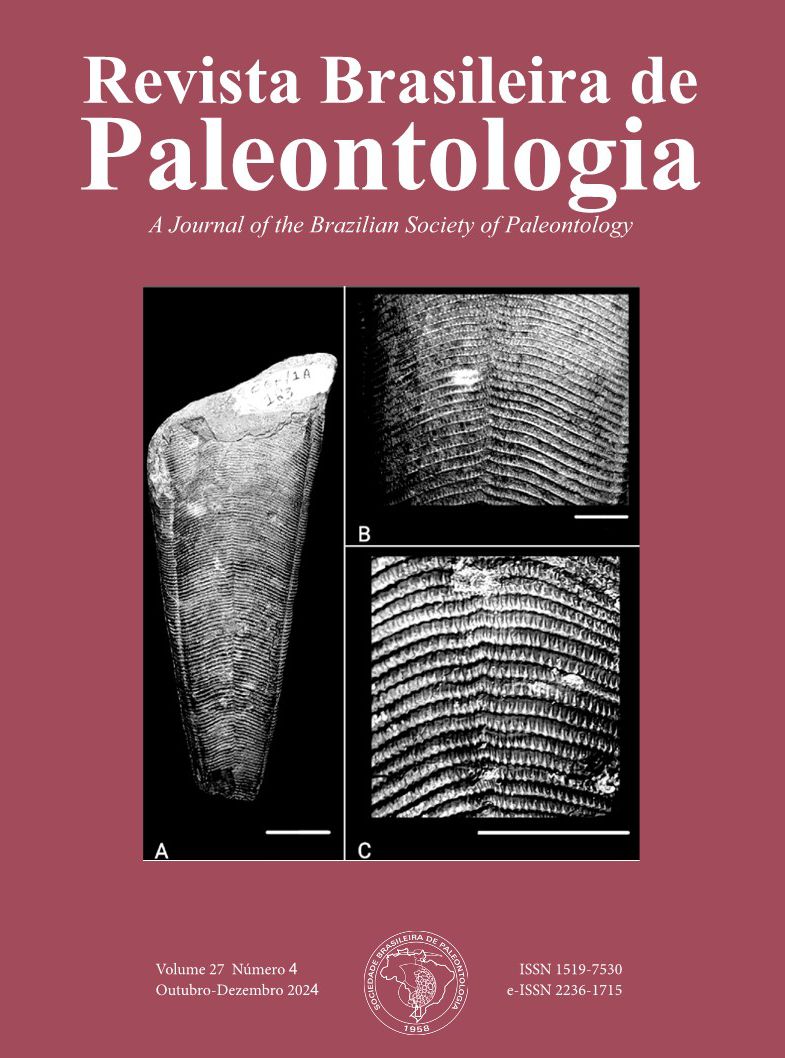Conulariids from the Ponta Grossa Formation in the southwest of Gondwana, Mato Grosso do Sul State, Brazil
DOI:
https://doi.org/10.4072/rbp.2024.4.0490Keywords:
Taxonomy, Conulariids, Devonian, Southwest Gondwana, PaleobiogeographyAbstract
In the Mato Grosso do Sul State, there are outcrops of Paleozoic marine deposits of the Paraná Basin, which are characterized by the presence of a rich fauna of fossilized invertebrates (i.e., conulariids, Cnidarians), in the municipalities of Rio Negro, Rio Verde do Mato Grosso and Coxim. These fossils are from the Devonian (Pragian–Emsian) Ponta Grossa Formation and are very important for acquiring paleobiological and paleogeographical information on the Malvinokaffric Fauna. The conulariids analyzed were recorded in outcrops from the Rio Verde (P3), Fênix (P4) and Araras-Figueira (P6) mines. The conulariids belong to two species Paraconularia africana and Conularia quichua, with the latter predominating. Notably, the fossils are so well-preserved that the internal structures (e.g., axial pillar and carina) in the basal region of the theca are visible. According to literature data, rocks of the Ponta Grossa Formation from the Rio Negro and Coxim regions (e.g., outcrops MS14 Estância Nhecolândia and MS65 Corredeira do Caeté) also revealed the presence of Conularia quichua, Paraconularia africana, Paraconularia ulrichana and Reticulaconularia caetensis. These species have been broadly paleobiogeographic distributed in the Andeo-South African and Interior Gondwana seas bioregions.
Keywords: taxonomy, conulariids, Devonian, Southwest Gondwana, paleobiogeography.
Resumo – No Estado do Mato Grosso do Sul ocorrem afloramentos de depósitos marinhos paleozoicos da Bacia do Paraná, caracterizados pela presença de uma rica fauna de invertebrados fossilizados (conularídeos, cnidários), nos municípios de Rio Negro, Rio Verde do Mato Grosso e Coxim. Esses fósseis são da Formação Ponta Grossa, Devoniano (Pragiano–Emsiano), e são muito importantes para a aquisição de informações paleobiológicas e paleogeográficas sobre a Fauna Malvinocáfrica. Os conularídeos analisados foram registrados em afloramentos das minas Rio Verde (P3), Fênix (P4) e Araras-Figueira (P6). Os conularídeos pertencem a duas espécies Paraconularia africana e Conularia quichua, com predominância desta última. Notavelmente, os fósseis estão tão bem preservados que as estruturas internas (e.g., pilar axial e carina) na região basal da teca são visíveis. Segundo dados da literatura, rochas da Formação Ponta Grossa das regiões Rio Negro e Coxim (e.g., afloramentos MS14 Estância Nhecolândia e MS65 Corredeira do Caeté), também revelaram a presença de Conularia quichua, Paraconularia africana, Paraconularia ulrichana e Reticulaconularia caetensis. Essas espécies possuem uma ampla distribuição paleobiogeográfica nas bioregiões dos mares Andino-Sul-Africano e do Interior de Gondwana.
Palavras-chave: taxonomia, conulários, Devoniano, Sudoeste Gondwana, paleobiogeografia.
Downloads
Downloads
Published
How to Cite
Issue
Section
License
Copyright (c) 2025 Edna M. Facincani, Juliana M. Leme, Fábio Henrique Cortes Faria, Dannihyure S. M. Souza

This work is licensed under a Creative Commons Attribution-NonCommercial-NoDerivatives 4.0 International License.
This is an Open Access article distributed under the terms of the Creative Commons Attribution-NonCommercial-NoDerivatives license (http://creativecommons.org/licenses/by-nc-nd/4.0), which permits non-commercial re-use, distribution, and reproduction in any medium, provided that no alterations are made and the original article is properly cited. The written permission of Revista Brasileira de Paleontologia must be obtained before any commercial use and/or adaptation of the article.







